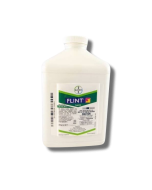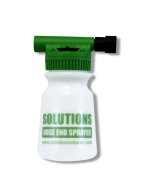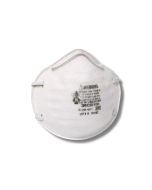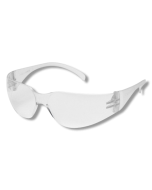Gain access to personalized product screening, the best pricing, rewards, and more!
Flint Fungicide
Flint Fungicide is a broad-spectrum fungicide containing the active ingredient Trifloxystrobin. It is used to control diseases like powdery mildew, rust, and scab on crops. It's also effective in protecting grapes, pome fruits, root vegetables, and more.
Flint Fungicide, manufactured by Bayer, is an effective fungicide that contains an active strobilurin ingredient. Flint helps to deliver long-lasting control of diseases on plants and crops.
The active ingredient forms a strong barrier against infection and travels through the leaf tissue.
Flint Fungicide removes diseases from a plant and prevents any future risks of infection with every application.
Tools Needed
For large-volume applications, you will need a hose-end sprayer, handheld pump sprayer, backpack sprayer, or spray rig.
How to Use
- Step 1: Determine how much Flint Fungicide you will need by calculating the square footage of the treatment area. To do this, measure the treatment area's length and width in feet, then multiply them together (length x width = square footage). To get acreage, take the square footage and divide by one acre (square footage / 43,560 sq. ft. = acres). Flint Fungicide can be mixed at a rate of 3-4 oz. per acre in a minimum of 50 gallons per acre. Refer to the product label for specific application rates and restrictions.
- Step 2: Add half the required amount of water to the mix tank and then with the agitator running, add the Flint Fungicide to the tank. Fill with the remaining half of water and continue mixing until the solutions is well mixed.
- Step 3: Spray the fungicide onto the leaf of the plant, placing the sprayer on a fan spray setting for even coverage. Repeat applications can be made at 14 to 21 day intervals for continued control and prevention of vulnerable plants.
Where to Use
Flint Fungicide is primarily used to treat croplands and agricultural settings to protect various fruits but it can also be used on ornamentals, and certain areas of landscape turf.
When to Use
Use when your crops or plants are suffering from diseases such as powdery mildew, blight, rot or leaf spot. Flint Fungicide is based used preventatively when conditions are favorable for the particular disease.
Safety Information
Flint Fungicide is safe to use around children and pets when applied according to the product label instructions. Always wear the proper personal protective equipment (PPE) when mixing and applying this product.
Listed fruit may be harvested on the day of the last application of Flint Fungicide once the spray has dried.
Keep people and pets away from treated areas until the treated area has completely dried.
Special Considerations
Areas planted with trifloxystrobin treated seeds or treated crops on this label may be replanted immediately following harvest with any crop for which a trifloxystrobin tolerance exists. For crops without trifloxystrobin tolerances, do not plant back within 30 days of the last application.
| Availability | Online |
| Restricted Use | No |
| Shipping Restrictions * = not registered** = restricted use | 20 Ounce: AK*, VT** |
| Brand | ENVU (FORMERLY BAYER) |
| Keith's Pro Tips | "Treat diseases on crops early and often with Flint Fungicide. Spray every few weeks for continued protection from plant disease all season long." |
| Product Drawbacks | Resistance may develop when applied to some plants if applied frequently. Limit application to no more than 2 applications per season if this occurs. |
| Target Pests | Flint Fungicide will control Alternaria Leaf Spot, Anthracnose, Bitter Rot, Black Rot, Botrytis Bunch Rot, Cedar Apple Rust, Downy Mildew, Early Blight, Fly Speck, Gray Leaf Spot, Gray Mold, Late Blight, Leaf Blight, Leaf Spot, Phomopsis Cane, Phomopsis Leaf Blight, Plectosporium Blight, Powdery Mildew, Rust, Scab, Septoria Leaf Spot, Soft Rot, Sooty Blotch, Stemphyllium Purple Spot, and White Rot. For more target pests please refer to the label. |
| Application Equipment | Pump Sprayer |
| Active Ingredient | Trifloxystrobin 50% |
| Product Type | Fungicide |
| Formulation | Suspended Concentrate |
| Application Rate | You will use 3-4 oz. per acre. Make uniform applications in a minimum 30 gallons per acre. For more specific application rates please refer to the label. |
| Shelf Life | Flint Fungicide can last for 1 to 2 years when stored in a cool, dry place. |
| Yield | A 20 ounce bottle of Flint Fungicide can treat up to 6 acres of land depending on the disease you wish to treat and where you are treating. |
| Use Sites | Indoors, Outdoors |
| Time to Kill | Begin applications preventively and continue as needed on a 14-day interval. |
| Comparable Products | Patch Pro |
| EPA Registration # | 264-777 |
| Restricted Use | No |
|---|---|
| Shipping Restrictions | AK |
| Availability | Online |
| Signal Word | CAUTION |
| Keith's Pro Tip | "Treat diseases on crops early and often with Flint Fungicide. Spray every few weeks for continued protection from plant disease all season long." |
| Time to Kill | Begin applications preventively and continue as needed on a 14-day interval. |
| Chemical Type | Fungicide |
| Formulation | Suspended Concentrate |
| Product Drawbacks | Resistance may develop when applied to some plants if applied frequently. Limit application to no more than 2 applications per season if this occurs. |
| Active Ingredient | Trifloxystrobin 50% |
| Application Equipment | Pump Sprayer |
| Mix Rate | You will use 3-4 oz. per acre. Make uniform applications in a minimum 30 gallons per acre. For more specific application rates please refer to the label. |
| Use Sites | Indoors, Outdoors |
| Yield | A 20 ounce bottle of Flint Fungicide can treat up to 6 acres of land depending on the disease you wish to treat and where you are treating. |
| EPA Registration No. | 264-777 |
| Shelf Life | Flint Fungicide can last for 1 to 2 years when stored in a cool, dry place. |
| Comparable Products | Patch Pro |
| Children or pets? | No |
| Property Characteristics | None |
*Price does not include freight. We guarantee our rate plus shipping will be less than anyone else's price.













